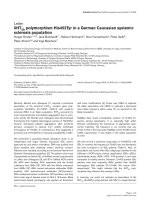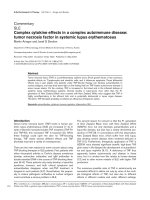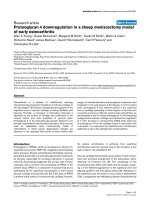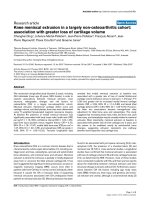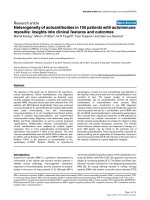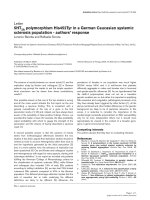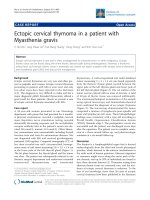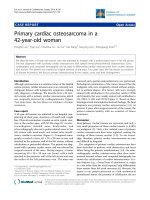Báo cáo y học: " De Toni-Debré-Fanconi syndrome in a patient with Kearns-Sayre syndrome: a case report" pot
Bạn đang xem bản rút gọn của tài liệu. Xem và tải ngay bản đầy đủ của tài liệu tại đây (1.42 MB, 6 trang )
BioMed Central
Page 1 of 6
(page number not for citation purposes)
Journal of Medical Case Reports
Open Access
Case report
De Toni-Debré-Fanconi syndrome in a patient with Kearns-Sayre
syndrome: a case report
Cristina Maria Mihai*
1
, Doina Catrinoiu
2
, Marius Toringhibel
3
,
Ramona Mihaela Stoicescu
4
and Anca Hancu
5
Address:
1
Pediatric Department for Diabetes, Nutrition and Metabolic Disorders in Children, 'Ovidius' University Constanta, Faculty of Medicine,
900591 Constanta, Romania,
2
Adult Department for Diabetes, Nutrition and Metabolic Disorders in Adults, 'Ovidius' University Constanta,
Faculty of Medicine, 900591 Constanta, Romania,
3
Department of Cardiology, 'Ovidius' University Constanta, Faculty of Medicine, 900591
Constanta, Romania,
4
Laboratory Department, 'Ovidius' University Constanta, Faculty of Medicine, 900591 Constanta, Romania and
5
Department of Neurology, 'Ovidius' University Constanta, Faculty of Medicine, 900591 Constanta, Romania
Email: Cristina Maria Mihai* - ; Doina Catrinoiu - ; Marius Toringhibel - ;
Ramona Mihaela Stoicescu - ; Anca Hancu -
* Corresponding author
Abstract
Introduction: Kearns-Sayre syndrome is a mitochondrial myopathy that demonstrates chronic
progressive ophthalmoplegia with onset before the age of 20 and pigmentary degeneration of the
retina.
Case presentation: We report the case of an 18-year-old Romanian man with short stature,
external ophthalmoplegia, palpebral ptosis, myopathy, sensorineural hearing impairment, cerebellar
ataxia, cardiac conduction defect, diabetes mellitus, hypoparathyroidism and hyperaldosteronism.
The patient's evolution showed progressive insufficiency of the renal tubule: hyperphosphaturia,
hyperaminoaciduria and, later, glucosuria (de Toni-Debré-Fanconi syndrome), a syndrome, to date,
rarely diagnosed in association with complete Kearns-Sayre syndrome. The final diagnosis was
delayed for several years and was only established when he developed diabetes mellitus. Southern
blot analysis and polymerase chain reaction amplification revealed the presence of a deletion in the
mitochondrial DNA.
Conclusion: Despite the rarity of this syndrome, the diagnosis was easily made due to the
presence of the classic triad: external ophthalmoplegia, pigmentary retinopathy and onset in a
patient younger than 20 years old. In our opinion, a search for Kearns-Sayre syndrome in all
patients with de Toni-Debré-Fanconi syndrome is a valuable medical routine.
Introduction
Mitochondria, which are found in almost all eukaryotic
cells, are the sites of oxidative metabolism and are thus
responsible for generating most of the adenosine-5'-tri-
phosphate (ATP) derived from the breakdown of organic
molecules. The concept of mitochondrial disease was
introduced in 1962, when Luft and co-workers described
a young woman with severe, non-thyroidal hypermetabo-
lism due to loose coupling of oxidation and phosphoryla-
tion in muscle mitochondria [1]. Because many
mitochondrial diseases involve brain and skeletal muscle,
these disorders are also known as mitochondrial enceph-
Published: 3 November 2009
Journal of Medical Case Reports 2009, 3:101 doi:10.1186/1752-1947-3-101
Received: 27 November 2008
Accepted: 3 November 2009
This article is available from: />© 2009 Mihai et al; licensee BioMed Central Ltd.
This is an Open Access article distributed under the terms of the Creative Commons Attribution License ( />),
which permits unrestricted use, distribution, and reproduction in any medium, provided the original work is properly cited.
Journal of Medical Case Reports 2009, 3:101 />Page 2 of 6
(page number not for citation purposes)
alomyopathies. The fact that the respiratory chain is under
dual genetic control makes these disorders particularly
fascinating, because they involve both Mendelian and
mitochondrial genetics. Because mitochondria are ubiq-
uitous, every tissue in the body can be affected by mito-
chondrial deoxyribonucleic acid (mtDNA) mutations,
which is why mitochondrial diseases are often multisys-
temic. mtDNA mutations appear to cause an extensive
array of disorders. As the number and types of mitochon-
drial diseases increase, internists and subspecialists will be
in a pivotal position to recognize and treat these diseases.
Therapy for mitochondrial diseases is inadequate. In the
absence of a clear understanding of basic pathogenetic
mechanisms, treatments have been palliative or have
involved the indiscriminate administration of vitamins,
cofactors, and oxygen-radical scavengers, with the aim of
mitigating, postponing, or circumventing the postulated
damage to the respiratory chain [2,3].
Kearns-Sayre syndrome (KSS) is a related mitochondrial
myopathy that demonstrates the following: chronic pro-
gressive ophthalmoplegia (CPEO), onset before the age of
20 and pigmentary degeneration of the retina; abnormal
accumulation of colored (pigmented) material on the
nerve-rich membrane lining the eyes (atypical retinitis
pigmentosa) leads to chronic inflammation, progressive
degeneration, and wearing away of certain eye structures
[4]. In addition, KSS may include cardiac conduction
defects, cerebellar ataxia, and raised cerebrospinal fluid
(CSF) protein levels (> 100 mg/dl). KSS may affect many
organ systems, for example, diabetes, growth retardation
and/or short stature, hypoparathyroidism, myopathy,
bilateral sensorineural hearing loss, cataracts, dementia,
dystonia, and proximal renal tubular acidosis [5]. Other
findings may include muscle weakness, short stature,
hearing loss, and/or the loss of the ability to coordinate
voluntary movements (ataxia) due to problems affecting
part of the brain (cerebellum). Mitochondrial encephalo-
myopathies are disorders where a defect in genetic mate-
rial arises from a part of the cell structure that releases
energy (mitochondria), causing the brain and muscles to
function improperly (encephalomyopathies). In these
disorders, abnormally high numbers of defective mito-
chondria are present. In approximately 80% of cases of
KSS, tests will reveal missing genetic material (deletions)
involving the unique mtDNA [6].
The possibility of mitochondrial dysfunction needs to be
taken into account by every medical subspecialty [7]. KSS
occurs secondary to deletions in mtDNA that cause a par-
ticular phenotype (Online Mendelian Inheritance in Man
(OMIM) 53000) [5]. Despite the rarity of this syndrome,
the diagnosis could be easily made in the presence of the
classic triad: external ophthalmoplegia, pigmentary retin-
opathy and onset in a patient younger than 20 years old
[8].
Case presentation
We report the case of an 18-year-old Romanian man with
short stature, external ophthalmoplegia, palpebral ptosis,
myopathy, sensorineural hearing impairment, cerebellar
ataxia, cardiac conduction defect, diabetes mellitus,
hypoparathyroidism, and hyperaldosteronism. The
patient presented initially with endocrinological abnor-
malities such as failure to thrive, hyperaldosteronism and
hypoparathyroidism. Despite his palpebral ptosis and
progressive encephalomyopathy with cerebellar ataxia,
the initial diagnosis was not KSS. Subsequently, he devel-
oped progressive external ophthalmoplegia, retinopathy,
heart block, and diabetes mellitus. The diagnosis was
delayed for many years.
The patient's initial infant development was normal (Fig-
ure 1). The first physical sign noted by his parents was
growth retardation, but initially this was not related to any
disease or disorder. During the first 3 to 4 years of his
childhood, the most striking clinical sign was the failure
to thrive. The child was seen by several doctors, and based
on clinical examination and laboratory tests, an initial
diagnosis was made. In a different hospital, the patient
was diagnosed with renal tubular dysfunction with
decreased urine-concentrating ability, and excessive excre-
tion of potassium and magnesium. The renal dysfunction
was thought to have resulted from Bartter syndrome, due
to the presence of hyperaldosteronism and hypokalemia.
The renal phenotype characterized by hypokalemia,
hypomagnesemia, hyperreninemia, hyperaldosteronism
and nephrocalcinosis, resembling Bartter syndrome, was
Patient with Kearns-Sayre syndrome at 3 months of age (nor-mal appearance)Figure 1
Patient with Kearns-Sayre syndrome at 3 months of
age (normal appearance).
Journal of Medical Case Reports 2009, 3:101 />Page 3 of 6
(page number not for citation purposes)
diagnosed when the boy was 4 years old. Replacement of
substances lost in urine was started (potassium, vitamin
D, calcium), when carpopedal spasms occurred, therefore,
spironolactone was added. Despite the presence of meta-
bolic acidosis, the Bartter syndrome diagnosis was main-
tained, and oral bicarbonate was added. In addition,
drooping of the upper eyelid (ptosis) bilaterally was also
noted during his childhood (Figure 2A), but was very mild
and was probably ignored. Other muscles involved in
coordinating eye movements were affected next, growing
progressively weaker and resulting in paralysis of eye
movements (chronic progressive external ophthalmople-
gia) at 9 years of age. Muscle weakness extended to other
portions of his lower legs, then his face, throat (pharynx),
neck, and shoulders. Muscle weakness affected talking
and swallowing, as the disease progressed (Figure 2B). His
upper arms and legs were affected, resulting in progressive
impairment of coordinated movement and a very difficult
gait. The patient also developed visual difficulties as a tod-
dler, due to the abnormal accumulation of colored (pig-
mented) material on the delicate membrane that lines the
eyes (atypical retinitis pigmentosa) and progressive
degeneration of certain portions of the eye (pigmentary
degeneration of the retina). Additional physical character-
istics and symptoms in this patient included: develop-
mental delay; short stature (Figure 3); diminished muscle
tone; hearing loss; mental retardation; progressive mem-
ory loss and deterioration of intellectual abilities; and
multiple endocrine dysfunction. The combination hypo/
normotension, high serum renin and high serum aldos-
terone suggested secondary hyperaldosteronism. Renal
tubular wasting of potassium and magnesium was docu-
mented. Also, low immunoreactive parathyroid hormone
levels in the presence of hypocalcemia confirmed a diag-
nosis of hypoparathyroidism. The very first of these disor-
ders occurring in association with KSS was
hypoparathyroidism with hypocalcemia and hyperaldos-
teronism. The patient's evolution showed progressive
insufficiency of the renal tubule: hyperphosphaturia,
hyperaminoaciduria and, later, also glucosuria (de Toni-
Debré-Fanconi syndrome), a syndrome, to date, rarely
diagnosed in association with complete Kearns-Sayre syn-
drome.
The final diagnosis was established in our department,
when our patient developed diabetes mellitus and was
admitted with severe keto-acidosis, based on clinical man-
ifestations (since mitochondrial disorders affect respira-
tory chain function, the disorders may be expected to have
the greatest effect on cells or organ systems with the high-
est energy requirements, for example, the brain, skeletal
and cardiac muscle, sensory organs, kidneys), muscular
biopsy and additional laboratory findings and tests: low
(A) The patient with Kearns-Sayre syndrome at 7 years of age, when the eyelid ptosis was documented for the first timeFigure 2
(A) The patient with Kearns-Sayre syndrome at 7
years of age, when the eyelid ptosis was documented
for the first time. (B) The patient with Kearns-Sayre syn-
drome at 12 years of age when the diagnosis of diabetes mel-
litus was established. Note the progression of the palpebral
ptosis.
The patient with Kearns-Sayre syndrome (right) with an age-matched boy (left)Figure 3
The patient with Kearns-Sayre syndrome (right) with
an age-matched boy (left).
Journal of Medical Case Reports 2009, 3:101 />Page 4 of 6
(page number not for citation purposes)
magnesium and parathyroid hormone, increased lactic
acid, creatine phosphokinase and protein in CSF, abnor-
mal electroretinography and visual-evoked potential test-
ing. Southern blot analysis and polymerase chain reaction
(PCR) amplification revealed the presence of a deletion in
the mtDNA.
Investigations revealed lactic acidosis, electrolytic imbal-
ance and urinary loss of glucose and electrolytes second-
ary to proximal renal tubulopathy consistent with
Fanconi syndrome.
The diagnosis of Kearns-Sayre Syndrome was established
based on the three primary characteristics: CPEO, atypical
retinitis pigmentosa, and cardiomyopathy-cardiac con-
duction defects. Soon after the diagnosis of diabetes mel-
litus was established, we diagnosed the cardiomyopathy;
the presence of a complete right bundle branch block with
left anterior hemiblock and Mobitz type 2 second degree
atrioventricular (AV) block (Figure 4).
Microscopic examination of muscle biopsy tissue samples
revealed the presence of the ragged-red fibers.
The brain computed tomography scan was used to iden-
tify abnormal lesions affecting certain areas of the brain -
this procedure revealed signs of generalized cerebral and
cerebellar atrophy and areas of hypointensity in basal gan-
glia and the brain magnetic resonance imaging showed a
combination of high-signal foci in subcortical cerebral
white matter and in the brain stem, globus pallidus and
thalamus. Treatment of heart problems required a pace-
maker for AV block. He improved soon after the implan-
tation of a permanent endocardial pacemaker.
Neurosensorial hearing loss assessed by audiometry (Fig-
ure 5) necessitated bilateral hearing aids.
Diabetes mellitus was treated with insulin, using a combi-
nation of rapid-acting analogues and lente insulin and
hypoparathyroidism with 1,25-dihydroxycholecalciferol
and ketosteril (amino acids plus calcium). Coenzyme
Q10, riboflavin, and vitamins C and K were added to his
treatment. At 15 years of age, the patient started to
develop progressive kidney failure, and a treatment with
erythropoietin was started as well.
Discussion
The patient presented initially with endocrinological
abnormalities: failure to thrive, hyperaldosteronism and
hypoparathyroidism. Despite his palpebral ptosis and
progressive encephalomyopathy with cerebellar ataxia,
the initial diagnosis was delayed for many years, probably
because KSS is mainly recognized as a neurologic disorder
with variable encephalomyopathic symptoms.
During the first three to four years of his childhood, the
most striking clinical sign was the failure to thrive. Hypoc-
alcemic tetany occurred at the age of four, with paresthesia
and carpopedal spasms. At the same time, a renal pheno-
type characterized by hypokalemia, hypomagnesemia,
hyperreninemia, and hyperaldosteronism was diagnosed,
but the real diagnosis was not recognized by the doctors
initially involved in the child's care.
He was referred to our hospital by his general practitioner,
many years after the onset of this unusual combination of
signs and symptoms, when he developed diabetes melli-
tus, at the age of 12. Despite the myopathic presentation,
in association with several non-neurologic signs, the diag-
nosis of KSS was not suggested by any of the physicians.
Later, after the real diagnosis had been established in our
department, we were alert for other clinical and therapeu-
Electrocardiogram - cardiac conduction defectFigure 4
Electrocardiogram - cardiac conduction defect.
Journal of Medical Case Reports 2009, 3:101 />Page 5 of 6
(page number not for citation purposes)
tic implications, such as heart involvement, diabetes man-
agement and kidney failure. Managing diabetes in
patients with end-stage renal disease is often problematic,
because renal failure interferes with the metabolism of
glucose and insulin with wide fluctuations in the daily
blood glucose profile. For this reason, our option was to
choose a flexible insulin therapy for our patient, using a
combination of rapid-acting and long-acting insulin ana-
logues, based on the evidence that using insulin ana-
logues in patients with diabetes and renal failure is safe
and helps to avoid large fluctuations in blood glucose lev-
els [9]. KSS can involve many organs and systems. Clini-
cians must maintain constant and comprehensive
surveillance, and be especially alert for signs and symp-
toms of diabetes mellitus, heart block and for hypopar-
athyroidism, because the cardiovascular effects of
hypocalcemia, bradydysrhythmias or prolongation of the
QT interval could be life-threatening. Treating our patient
was very challenging because his evolution related to his
parathyroidism and hypocalcemia, and he had repeated
tetanic symptoms with generalized convulsions and stiff-
ness.
Cases with hypoparathyroidism have been considered to
constitute a distinct subgroup in the medical literature.
Dewhurst et al. [10] described a patient with KSS and
hypocalcemia without basal ganglia calcifications and
they assumed that this was due to the early treatment of
hypoparathyroidism. Later, cases of KSS with hypoparath-
yroidism were considered separately to assess if they con-
stituted a distinct subgroup with multiple endocrine
dysfunction [9]. Concerning the hypoparathyroidism,
this was associated with other endocrine and metabolic
dysfunctions, but the authors considered that this was
likely to be due to increased recognition rather than
increased prevalence, because bone or tooth abnormali-
ties and calcification of the basal ganglia were found in
those with and without hypoparathyroidism [11]. Four
years later, a group of Japanese authors reported a patient
with KSS in whom they described the presence of HLA-
A24 and CW3 antigen that could be responsible for the
association of insulin-dependent diabetes mellitus
(IDDM) and hypoparathyroidism, similar to Japanese
patients with polyglandular autoimmune syndrome, and
suggesting that a genetic linkage, as well as mitochondrial
dysfunction, may be responsible for the association of the
two disease states [12].
Considering the association of KSS with hypoparathy-
roidism, our patient presented with hypocalcemia at 4
years of age and the hypoparathyroidism was proven by
reduced serum concentrations of parathyroid hormone
(PTH) and hyperphosphatemia. No evidence of dietary,
malabsorbent, metabolic vitamin D disorders or autoim-
mune mechanisms, which have been assumed to cause
hypoparathyroidism in KSS, were noted in our patient.
Severe hypomagnesemia, known to suppress PTH secre-
tion, was also observed in this patient.
Searching the PubMed database, we found only eight arti-
cles describing the association between the presence of de
Toni-Debré-Fanconi syndrome and Kearns Sayre syn-
drome [13-20]. This highly unusual clinical presentation
emphasizes the need for systemic investigation of patients
with Fanconi syndrome and further underlines the impor-
tance of mtDNA analysis in patients with unexpected
associations of affected tissues [13]. Mitochondrial cytop-
athy is a multisystem disease that requires different phar-
macological and specialist approaches. Relationships
between retinal and kidney disorders advocate a search for
de Toni-Debré-Fanconi syndrome in all patients with
AudiogramFigure 5
Audiogram.
Publish with BioMed Central and every
scientist can read your work free of charge
"BioMed Central will be the most significant development for
disseminating the results of biomedical research in our lifetime."
Sir Paul Nurse, Cancer Research UK
Your research papers will be:
available free of charge to the entire biomedical community
peer reviewed and published immediately upon acceptance
cited in PubMed and archived on PubMed Central
yours — you keep the copyright
Submit your manuscript here:
/>BioMedcentral
Journal of Medical Case Reports 2009, 3:101 />Page 6 of 6
(page number not for citation purposes)
Kearns-Sayre syndrome and also the use of quantitative
and chromatographic methods for the assessment of
amino acids, phosphates and sugars in urine [14,15].
Conclusion
Despite the rarity of this syndrome, diagnosis could easily
be made in the presence of the classic triad: external oph-
thalmoplegia, pigmentary retinopathy and onset in a
patient younger than 20 years of age, if this clinical pres-
entation is recognized and identified as a mitochondrial
disorder.
We consider that practitioners should be aware of the
presence of mitochondrial myopathies, and the broad
spectrum of their clinical presentations. Also, the diagno-
sis of de Toni-Debré-Fanconi syndrome in a patient
should be followed by extensive research into the possible
presence of an associated mitochondrial myopathy.
Abbreviations
ATP: adenosine-5'-triphosphate; AV: atrioventricular;
CPEO: chronic progressive ophthalmoplegia; CSF: cere-
brospinal fluid; DNA: deoxyribonucleic acid; IDDM: insu-
lin-dependent diabetes mellitus; KSS: Kearns-Sayre
syndrome; mtDNA: mitochondrial deoxyribonucleic acid
Consent
Written informed consent was obtained from the patient's
parents for publication of this case report and any accom-
panying images. A copy of the written consent is available
for review by the Editor-in-Chief of this journal.
Competing interests
The authors declare that they have no competing interests.
Authors' contributions
MCM analyzed and interpreted the patient data regarding
the disease. CD and HA were major contributors in writ-
ing the manuscript. TM performed the cardiac examina-
tion and diagnosis. SR performed the laboratory tests. All
authors read and approved the final manuscript.
References
1. Luft R, Ikkos D, Palmieri G, Ernster L, Afzelius B: A case of severe
hypermetabolism of nonthyroid origin with a defect in the
maintenance of mitochondrial respiratory control: a corre-
lated clinical, biochemical, and morphological study. J Clin
Invest 1962, 41:1776-1804.
2. DiMauro S, Hirano M, Schon EA: Mitochondrial encephalomy-
opathies: therapeutic approaches. Neurol Sci 2000,
21:S901-S908.
3. Ogasahara S, Nishikawa Y, Yorifuji S, Soga F, Nakamura Y, Takahashi
M, Hashimoto S, Kono N, Tarui S: Treatment of Kearns-Sayre
syndrome with coenzyme Q10. Neurology 1986, 36(1):45-53.
4. Kearns TP, Sayre G: Retinitis pigmentosa, external ophthalmo-
plegia, and complete heart block: unusual syndrome with
histologic study in one of two cases. Arch Ophthalmol 1958,
6:280-289.
5. McKusick VA: Online Mendelian Inheritance in Man (OMIM) Baltimore.
MD: The Johns Hopkins University; Entry No: 530000.
6. Shoffner JM, Lott MT, Voljavec AS: Spontaneous Kearns-Sayre
syndrome/chronic external ophthalmoplegia plus syndrome
associated with a mitochondrial DNA deletion: a slip-replica-
tion model and metabolic therapy. Proc Natl Acad Sci USA 1989,
86:7952-7956.
7. Marin-Garcia J, Goldenthal MJ, Sarnat HB: Kearns-Sayre syn-
drome with a novel mitochondrial DNA deletion. J Child Neu-
rol 2000, 15:555-558.
8. Gal R: Progressive ptosis in children as a presenting sign of
Kearns-Sayre syndrome. Harefuah 2000, 138:108-110.
9. Jehle PM, Aisenpreis U, Bundschu D, Keller F: Advantages of insu-
lin Lispro (short-acting) in terminal kidney failure. Fortschr
Med 1999, 117(11):41-42.
10. Dewhurst AG, Hall D, Schwartz MS, McKeran RO: Kearns-Sayre
syndrome. hypoparathyroidism and basal ganglia calcifica-
tion. J Neurol Neurosurg Psychiatr 1986, 49:1323-1324.
11. Harvey JN, Barnett D: Endocrine dysfunction in Kearns-Sayre
syndrome. Clin Endocrinol (Oxf) 1992, 37(1):97-103.
12. Isotani H, Haruhiko Fukumoto Y, Kawamura H, Furukawa K, Ohsawa
N, Goto Y, Nishino I, Nonaka I: Hypoparathyroidism and insulin-
dependent diabetes mellitus in a patient with Kearns-Sayre
syndrome harbouring a mitochondrial DNA deletion. Clin
Endocrinol 1996, 45(5):637-641.
13. Pitchon EM, Cachat F, Jacquemont S, Hinard C, Borruat FX, Schor-
deret DF, Morris MA, Munier FL: Patient with Fanconi Syn-
drome (FS) and retinitis pigmentosa (RP) caused by a
deletion and duplication of mitochondrial DNA (mtDNA).
Klin Monatsbl Augenheilkd 2007, 224(4):340-343.
14. Zaffanello M, Zamboni G: Therapeutic approach in a case of
Pearson's syndrome. Minerva Pediatr 2005, 57(3):143-146.
15. Berio A, Piazzi A: Kearns-Sayre syndrome associated with de
Toni-Debré-Fanconi syndrome due to cytochrome-c-oxi-
dase (COX) deficiency. Panminerva Med 2001, 43(3):211-214.
16. Mochizuki H, Joh K, Kawame H, Imadachi A, Nozaki H, Ohashi T,
Usui N, Eto Y, Kanetsuna Y, Aizawa S: Mitochondrial encephalo-
myopathies preceded by de-Toni-Debré-Fanconi syndrome
or focal segmental glomerulosclerosis. Clin Nephrol 1996,
4(5):347-352.
17. Mori K, Narahara K, Ninomiya S, Goto Y, Nonaka I: Renal and skin
involvement in a patient with complete Kearns-Sayre syn-
drome. Am J Med Genet 1991, 38(4):583-587.
18. Goto Y, Itami N, Kajii N, Tochimaru H, Endo M, Horai S: Renal
tubular involvement mimicking Bartter syndrome in a
patient with Kearns-Sayre syndrome. J Pediatr 1990,
116(6):904-910.
19. Berio A: Primary Toni-Debré-Fanconi syndrome. Pediatr Med
Chir 1993, 15(1):79-85.
20. Kitano A, Nishiyama S, Miike T, Hattori S, Ohtani Y, Matsuda I: Mito-
chondrial cytopathy with lactic acidosis, carnitine deficiency
and De Toni-Fanconi-Debre syndrome. Brain Dev 1986,
8(3):289-295.
